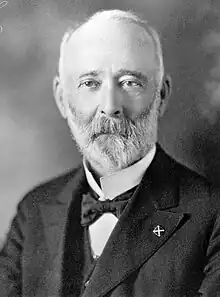Aurelius W. Hutton | |
|---|---|
 | |
| Justice of the Los Angeles County Superior Court | |
| In office 1875–1881 | |
| Personal details | |
| Born | July 23, 1847 Greene County, Alabama |
| Died | January 11, 1934 (aged 86) Santa Monica, California |
| Spouses | Elema Ward
(m. 1832; died 1834)Anna Maria Matlack (m. 1846) |
| Education | Virginia University |
| Occupation | Jurist, writer |
Aurelius W. Hutton (July 23, 1847 – January 11, 1934) was a Los Angeles County Superior Court judge and Los Angeles city attorney. He sat on a special jury that investigated charges made by land developer Abbot Kinney.
Biography
Hutton was born in Greene County, Alabama, on July 23, 1847, and was educated at the University of Virginia.[1] He came to Los Angeles in 1869 after having fought in the Confederate Army.[2][3]
He was Los Angeles city attorney in 1872–76 and a judge of the Los Angeles County Superior Court.[2] In August 1898, he was chairman of a rally at Hazard's Pavilion on behalf of James G. Maguire, candidate for governor of California.[4]
In 1904 Hutton was chairman of a specially appointed jury that heard charges by real estate developer and fruit grower Abbot Kinney against A. H. Naftzger. president of the California Fruit Agency and nominal head of the Southern California Fruit Exchange. He filed a 15-page dissent against the acquittal of Naftzger.[5]
He died at the age of 86 on January 11, 1934, in his home, 1704 Ocean View Avenue, Santa Monica. He was survived by his six children.[2] His oldest son, Aurelius W. Hutton Jr. had died in 1895 at the age of 19.[6]
References
- ↑ Shuck, Oscar T., ed. (1901). History of the Bench and Bar of California. Commercial Printing House. p. 713. Retrieved August 12, 2020 – via Google Books.
- 1 2 3 "Last Rites for Hutton Set Today," Los Angeles Times, January 12, 1934, page A-5
- ↑ "The New Judges," Los Angeles Times, February 18, 1887
- ↑ "Opening Gun of the Campaign, Los Angeles Herald, August 28, 1898
- ↑ "Kinney-Natzger," Los Angeles Times, August 28, 1904, page A-11
- ↑ "Died", Los Angeles Times, April 14, 1895, page 12